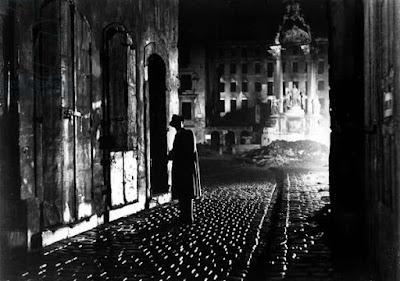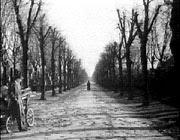The name Harry will probably give the game away and will almost certainly be given completely when I say that the sentence was written on the flap of an envelope by Graham Greene. That was the origin of the best British film ever made and I bet you a pound to a schilling that when the words 'The Third Man' are read you will hear that zither for the rest of the day.
I’m not going to go over the plot as most people will know it and for those who haven’t seen the film then I don’t want to spoil the treat that you will have in front of you. Suffice it to say that the story is based in Vienna after the end of the Second World War when the city was bombed out. Shadows are everywhere, the city itself becomes a character in the film.Much of the shooting was done at night, turning the streets into a labyrinth of darkness and light. Shadows sweep across buildings, and increasingly raked camera angles highlight not only the twists and turns of the story but the stunning street-wide views of Vienna, lavish interior design and images that perfectly juxtapose the city’s beauty with the rubble and ruins that scarred it during the war.
The director, Carol Reed, also uses shadows of the characters, showing them in silhouette or their figures cast across stone walls. The interplay of light and shadow is so vital to the whole structure of the film in that it juxtaposes perception and reality, the stresses of waiting or action, old and new morality, East and West, not the first or second man but the third.Reed managed to achieve much of the above by teaming up with Robert Krasker who used black and white expressionist cinematography with harsh lighting and Dutch angle camera techniques. This use of shadows and angles to create feelings of unease and discomfort is a basic of film noir. Dutch angles are when the camera is tilted on its side.I came across a good tip when I was looking into the history of the film and that is you have to watch it with the lights off or you will miss the deep, silken blacks and the subtle gradations of shadow to ambient glare. The critic also mentions how slowly a scene can take to unfold, this does not cause boredom as each character, and hence yourself, is waiting on pins and needles as the tension builds.I was using the critic’s words when she mentioned ‘ambient light’ above but whenever I think of the tone or color of the film I think ‘grey’. Just for the sake of it I tried to, off the top of my head, to think of a film that conjures up the opposite feeling and I came up with ‘West Side Story’.The title of the film achieved the distinction of entering the English language almost immediately (in 1949). Again off the top of my head I’m thinking ‘Catch 22’, ‘The Full Monty’, ‘Groundhog Day’.Back to 'The Third Man '. I would urge those who have seen it before and those who haven’t seen it at all to watch the film now. I need to know someone else can’t get rid of that zither music.
 Just to make it clear, the poem is not to do with 'The Third Man ', so I’m not giving any plot spoilers.
Just to make it clear, the poem is not to do with 'The Third Man ', so I’m not giving any plot spoilers.Aberystwyth
You’re not looking back,
turning the corner
in the shadows
of a street lamp,
your daft bag glistening
in the fine rain
of a fine town,
cooling the night,
setting a scene
where I’m pointing,
telling the crew
it’s a single take,
black background,
light drained,
the sound of waves
hits the cutting room floor,
all the screen is yours,
just do nothing.
For I know the movie,
I’ve seen it before,
we’ve seen it today
where a girl leaves,
there’s a guy from the past,
the phone rings
and it’s all over
in ninety minutes.
So keep going,
let me finish,
it’s my shot
and I don’t want you
looking back.
(first published in Poetry Monthly, 2008)
Thanks for reading, Terry. Email ThisBlogThis!Share to TwitterShare to Facebook
